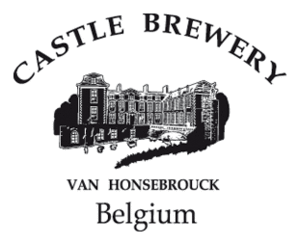Brouwerij Van Honsebrouck
Website (Dutch, French, English, Spanish): http://www.vanhonsebrouck.be

Phone: +32(0)51 33 51 60
Address: Oostrozebekestraat 43, 8770 Ingelmunster
Overview
Van Honsebrouck is a producer of spontaneous fermentation beers as well as ales and lagers. The brewery began producing to spontaneously fermend beers based on the the success of Belle-Vue 1950s. By the early 70's they were brewing their own lambic-style products, using a koelschip and foeders for aging.
History
The history of Brouwerij Van Honsebrouck dates back to the mid-1800's when Amandus Van Honsebrouck founded his first brewery. After passing away in 1865 his son Emile took over the brewery and at the age of 21. In 1900, Emile Van Honsebrouck moved to Inglemnuster with his wife Louise and founded the Sint-Jozef Brewery. By 1922, the brewery was in its third generation of family ownership under Emile's sons Paul and Ernest Van Honsebrouck who began to expand the brewing storage and capacity with addition of a new malt house and foeder room in 1930 and a new brewing room, fermentation room, tank room and bottling plant in 1939. [1]
In early 1950, Van Honsebrouck began distributing Belle Vue and observed the increasing demand for the beer.[2] In 1953, Luc Van Honsebrouck, the son of Paul, goes to brewery school and completes apprenticeships in Wallonia and Germany. He then took over the brewery and renamed it Brewery Van Honsebrouck. By 1955, Luc Van Honsebrouck decided to stop brewing lagers and focus on his own Oud Bruin recipe which was named Bacchus. In 1958, the brewery began buying wort from Van Haelen Fréres in Uccle to produce what they called a gueuze and later a kriek.[3] [1]
Wort was transferred into oak foeders that held Bacchus and blended with a house-brewed wort. This eventually inoculated the yeast culture into the foeders which lead to in-house production of spontaneously fermented ale after their wort supplier ceased production. In an attempted to replicate the environment in the Pajottendland the brewer experimented with trucking their wort into the region for cooling. The experiment was ultimately unsuccessful, and all spontaneous fermentation is done in-house today.[2] In 1969 Van Honsebrouck became the second largest "gueuze" producer in Belgium behind Belle-Vue using700,000 kg of malt.
In 1986 Van Honsebrouck introduced the Kasteel line of beers which are not spontaneously fermented. [1] Since 1997, Van Honsebrouck has produced what they call a traditional product, Gueuze Fond Tradition. Wood shavings and oak bars were used from 2008 until 2012 when new foeders were set up for the beers.[2] In 2009, Xavier Van Honsebrouck took over the brewery as the 5th generation owner. As of 2010, 45% of the annual production is dedicated to spontaneous fermentation beers.[2]
The brewery is planning to move to a 7.5-acre site of the former furniture factory in Izegem. The new brewery will have a capacity of 200,000 hectoliters, doubling that of the current brewery in Inglemunster.[1]
Van Honsebrouck Definition of Lambic
When Van Honesbrouck began making what they view as lambic around 1958 they were indeed bringing in wort from a bona fide lambic producer in the Pajottenland. Capitalizing on the popularity of sweetened lambic, Luc Van Honsebrouck saw a business opportunity. What he did not see, according to Raymond Buren, was the uniqueness of the product to the Senne Valley. Buren quotes Van Honsebrouck: "The Senne, he says, is the sewer of Brussels." Van Honsebrouck goes on to wonder who created the geographic border typically recongized by lambic producers anyhow. "Kobbegem isn’t in the Pajottenland”, he notes (refering to Mort Subite. “My gueuze conforms to the taste of the times, it’s refreshing and sells well in France, it’s from that perspective that I’ve named it St. Louis.”[3]
Luc Van Honsebrouck also took issue with the Royal Decree of 1965 which sought to protect lambic against counterfeiting. It stated a geographical boundary of 20km around Brussels was the defined area for lambic production. He learned of this almost by accident, after a visit from lambic brewer Edgar Winderickx, whom he knew from his brewing school days. He appealed against the Royal Decree, and won with the argument that "If Brussels says people can't make gueze in Ingelmunster, then it simply would not work there". [2]
Presently, the Van Honsebrouck brewery uses a coolship to spontaneously ferment their Saint Louis line of beers and uses aged hops.[4]
Beers
- Saint Louis Cassis
- Saint Louis Gueuze Fond Tradition
- Saint Louis Kriek Fond Tradition
- Saint Louis Premium Faro
- Saint Louis Premium Gueuze
- Saint Louis Premium Framboise
- Saint Louis Premium Kriek
References
- ↑ 1.0 1.1 1.2 1.3 Brouwerij Van Honsebrouck, Brewery History
- ↑ 2.0 2.1 2.2 2.3 2.4 Jef Van den Steen, Geuze & Kriek: The Secret of Lambic Beer, 2012
- ↑ 3.0 3.1 Raymond Buren, Gueuze, Faro, et Kriek, 1992
- ↑ Brouwerij Van Honsebrouck, Brewing Process